Pentacoordinate Mixed-Ligand Zn(II) Complexes with Flufenamato and Niflumato Ligands: Crystal Structure, Spectral Characterization and Biological Properties
Abstract
:1. Introduction
2. Materials and Methods
2.1. Chemicals and Physical Measurements
2.2. Synthesis of the [ZnCl(flu)(neo)] (1A and 1B), and [ZnCl(nif)(biq)] (2)
2.3. Single-Crystal X-ray Crystallography
2.4. Hirshfeld Surface Analysis
2.5. FS DNA Binding Experiments
2.6. Albumin Binding Experiments
3. Results and Discussion
3.1. Preparation and Characterization of the Complexes
3.2. Crystal Structures
3.3. Hirshfeld Surface Analysis
3.4. IR Spectroscopy
3.5. UV-VIS and Fluorescence Spectroscopy
3.6. DNA Binding Studies
3.7. Albumin Binding Studies
4. Conclusions
Supplementary Materials
Author Contributions
Funding
Data Availability Statement
Acknowledgments
Conflicts of Interest
References
- Krężel, A.; Maret, W. The biological inorganic chemistry of zinc ions. Arch. Biochem. Biophys. 2016, 611, 3–19. [Google Scholar] [CrossRef]
- Lakshman, T.R.; Deb, J.; Paine, T.K. Anti-inflammatory activity and enhanced COX-2 selectivity of nitric oxide-donating zinc(ii)-NSAID complexes. Dalton Trans. 2016, 45, 14053–14057. [Google Scholar] [CrossRef]
- Sharma, J.; Singla, A.K.; Dhawan, S. Zinc-naproxen complex: Synthesis, physicochemical and biological evaluation. Int. J. Pharm. 2003, 260, 217–227. [Google Scholar] [CrossRef]
- Santos, A.C.F.; Monteiro, L.P.G.; Gomes, A.C.C.; Martel, F.; Santos, T.M.; Ferreira, B.J.M.L. NSAID-Based Coordination Compounds for Biomedical Applications: Recent Advances and Developments. Int. J. Mol. Sci. 2022, 23, 2855. [Google Scholar] [CrossRef]
- Smolková, R.; Zeleňák, V.; Gyepes, R.; Hudecová, D. Biological Activity of Two Novel Zinc(II) Complexes with NSAID Mefenamic Acid. Chem. Pap. 2019, 74, 1525–1540. [Google Scholar] [CrossRef]
- Smolková, R.; Zeleňák, V.; Gyepes, R.; Sabolová, D.; Imrichová, N.; Hudecová, D.; Smolko, L. Synthesis, Characterization, DNA Binding, Topoisomerase I Inhibition and Antimicrobial Activity of Four Novel Zinc(II) Fenamates. Polyhedron 2018, 141, 230–238. [Google Scholar] [CrossRef]
- Smolková, R.; Zeleňák, V.; Smolko, L.; Sabolová, D.; Kuchár, J.; Gyepes, R. Novel Zn(II) Complexes with Non-Steroidal Anti-Inflammatory Ligand, Flufenamic Acid: Characterization, Topoisomerase I Inhibition Activity, DNA and HSA Binding Studies. J. Inorg. Biochem. 2017, 177, 143–158. [Google Scholar] [CrossRef]
- Psomas, G. Copper(II) and Zinc(II) Coordination Compounds of Non-Steroidal Anti-Inflammatory Drugs: Structural Features and Antioxidant Activity. Coord. Chem. Rev. 2020, 412, 213259. [Google Scholar] [CrossRef]
- Lakshman, T.R.; Deb, J.; Ghosh, I.; Sarkar, S.; Paine, T.K. Combining Anti-Inflammatory and Anti-Proliferative Activities in Ternary Metal-NSAID Complexes of a Polypyridylamine Ligand. Inorg. Chim. Acta 2019, 486, 663–668. [Google Scholar] [CrossRef]
- Deb, J.; Lakshman, T.R.; Ghosh, I.; Jana, S.S.; Paine, T.K. Mechanistic Studies of in Vitro Anti-Proliferative and Anti-Inflammatory Activities of the Zn(ii)–NSAID Complexes of 1,10-Phenanthroline-5,6-Dione in MDA-MB-231 Cells. Dalton Trans. 2020, 49, 11375–11384. [Google Scholar] [CrossRef]
- Graham, G.G. Fenamates. In Compendium of Inflammatory Diseases; Springer: Basel, Switzerland, 2016; pp. 477–482. [Google Scholar] [CrossRef]
- Greenhough, A.; Smartt, H.J.M.; Moore, A.E.; Roberts, H.R.; Williams, A.C.; Paraskeva, C.; Kaidi, A. The COX-2/PGE2 Pathway: Key Roles in the Hallmarks of Cancer and Adaptation to the Tumour Microenvironment. Carcinog. 2009, 30, 377–386. [Google Scholar] [CrossRef]
- Zappavigna, S.; Cossu, A.M.; Grimaldi, A.; Bocchetti, M.; Ferraro, G.A.; Nicoletti, G.F.; Filosa, R.; Caraglia, M. Anti-Inflammatory Drugs as Anticancer Agents. Int. J. Mol. Sci. 2020, 21, 2605. [Google Scholar] [CrossRef]
- Porchia, M.; Pellei, M.; Del Bello, F.; Santini, C. Zinc Complexes with Nitrogen Donor Ligands as Anticancer Agents. Molecules 2020, 25, 5814. [Google Scholar] [CrossRef]
- Karges, J.; Stokes, R.W.; Cohen, S.M. Metal Complexes for Therapeutic Applications. Trends Chem. 2021, 3, 523–534. [Google Scholar] [CrossRef]
- Renfrew, A.K. Transition Metal Complexes with Bioactive Ligands: Mechanisms for Selective Ligand Release and Applications for Drug Delivery. Metallomics 2014, 6, 1324–1335. [Google Scholar] [CrossRef]
- Groom, C.R.; Bruno, I.J.; Lightfoot, M.P.; Ward, S.C. The Cambridge Structural Database. Acta Crystallog. B Struct. Sci. Cryst. Eng. Mater. 2016, 72, 171–179. [Google Scholar] [CrossRef]
- Oxford Diffraction, CrysAlis PRO, Version 1.171.38.43; Oxford Diffraction Ltd., Yarnton, Oxfordshire: Oxford, UK, 2015.
- Sheldrick, G.M. Crystal Structure Refinement with SHELXL. Acta Crystallogr. C Struct. Chem. 2015, 71, 3–8. [Google Scholar] [CrossRef]
- Petříček, V.; Palatinus, L.; Plášil, J.; Dušek, M. Jana2020—A New Version of the Crystallographic Computing System Jana. Z. Krist—Cryst. Mater. 2023, 238, 271–282. [Google Scholar] [CrossRef]
- Química Inorganica. SHAPE 2.1 Software; Universitat de Barcelona: Barcelona, Spain, 2013. [Google Scholar]
- Spek, A.L. Single-Crystal Structure Validation with the ProgramPLATON. J. Appl. Crystallogr. 2003, 36, 7–13. [Google Scholar] [CrossRef]
- DIAMOND, Version 3.2 k; Crystal Impact GbR: Bonn, Germany, 2014.
- Spackman, P.R.; Turner, M.J.; McKinnon, J.J.; Wolff, S.K.; Grimwood, D.J.; Jayatilaka, D.; Spackman, M.A. CrystalExplorer: A Program for Hirshfeld Surface Analysis, Visualization and Quantitative Analysis of Molecular Crystals. J. Appl. Crystallogr. 2021, 54, 1006–1011. [Google Scholar] [CrossRef]
- Galindo-Murillo, R.; Cheatham, T.E., III. Ethidium Bromide Interactions with DNA: An Exploration of a Classic DNA–Ligand Complex with Unbiased Molecular Dynamics Simulations. Nucleic Acids Res. 2021, 49, 3735–3747. [Google Scholar] [CrossRef]
- The IUPAC Compendium of Chemical Terminology; Royal Society of Chemistry: Cambridge, UK, 2019. [CrossRef]
- Lakowicz, J.R. Principles of Fluorescence Spectroscopy, 3rd ed.; Springer: Boston, MA, USA, 2006; ISBN 978-0-387-31278-1. [Google Scholar]
- Preston, H.S.; Kennard, C.H.L. Stereochemistry of Rigid Chelate–Metal Complexes. Part I. The Crystal Structure of Dichloro-(2,9-Dimethyl-1,10-Phenanthroline)Zinc(II). J. Chem. Soc. A 1969, 1969, 1956–1961. [Google Scholar] [CrossRef]
- Muranishi, Y.; Wang, Y.; Odoko, M.; Okabe, N. (2,2′-Biquinoline-κ2N,N′)Dichloropalladium(II), -Copper(II) and -Zinc(II). Acta Crystallogr. C 2005, 61, m307–m310. [Google Scholar] [CrossRef]
- Tarushi, A.; Raptopoulou, C.P.; Psycharis, V.; Kessissoglou, D.P.; Papadopoulos, A.N.; Psomas, G. Interaction of Zinc(II) with the Non-Steroidal Anti-Inflammatory Drug Niflumic Acid. J. Inorg. Biochem. 2017, 176, 100–112. [Google Scholar] [CrossRef]
- Li, P.; Maier, J.M.; Vik, E.C.; Yehl, C.J.; Dial, B.E.; Rickher, A.E.; Smith, M.D.; Pellechia, P.J.; Shimizu, K.D. Stabilizing Fluorine–π Interactions. Angew. Chem. Int. Ed. 2017, 56, 7209–7212. [Google Scholar] [CrossRef]
- Panigrahi, S.K.; Desiraju, G.R. Strong and Weak Hydrogen Bonds in Drug-DNA Complexes: A Statistical Analysis. J. Biosciences 2007, 32, 677–691. [Google Scholar] [CrossRef]
- Pietruś, W.; Kafel, R.; Bojarski, A.J.; Kurczab, R. Hydrogen Bonds with Fluorine in Ligand–Protein Complexes-the PDB Analysis and Energy Calculations. Molecules 2022, 27, 1005. [Google Scholar] [CrossRef]
- Tarushi, A.; Totta, X.; Raptopoulou, C.P.; Psycharis, V.; Psomas, G.; Kessissoglou, D.P. Structural Features of Mono- and Tri-Nuclear Zn(Ii) Complexes with a Non-Steroidal Anti-Inflammatory Drug as Ligand. Dalton Trans. 2012, 41, 7082. [Google Scholar] [CrossRef]
- Hadjiivanov, K.I.; Panayotov, D.A.; Mihaylov, M.Y.; Ivanova, E.Z.; Chakarova, K.K.; Andonova, S.M.; Drenchev, N.L. Power of Infrared and Raman Spectroscopies to Characterize Metal-Organic Frameworks and Investigate Their Interaction with Guest Molecules. Chem. Rev. 2020, 121, 1286–1424. [Google Scholar] [CrossRef]
- Feng, J.; Su, B.; Yi, X.; Kong, Z.; Chang, L. Two New Zinc(Ii) Coordination Complexes Constructed by Phenanthroline Derivate: Synthesis and Structure. Main. Group. Met. Chem. 2023, 46, 20228042. [Google Scholar] [CrossRef]
- Diana, R.; Panunzi, B. The Role of Zinc(II) Ion in Fluorescence Tuning of Tridentate Pincers: A Review. Molecules 2020, 25, 4984. [Google Scholar] [CrossRef]
- Smolko, L.; Špaková, I.; Klepcová, Z.; Dubayová, K.; Samoľová, E.; Rabajdová, M.; Mareková, M. Zinc(II) Niflumato Complex with Neocuproine: Synthesis, Crystal Structure, Characterization and Cytotoxic Effects on Human Endometrial Cell Lines. J. Mol. Struct. 2021, 1237, 130312. [Google Scholar] [CrossRef]
- Tian, G.; Han, Y.-Z.; Yang, Q. 1, 10-Phenanthroline Derivative as Colorimetric and Ratiometric Fluorescence Probe for Zn2+ and Cd2+. Results Chem. 2023, 5, 100899. [Google Scholar] [CrossRef]
- Smolková, R.; Smolko, L.; Zeleňák, V.; Kuchár, J.; Gyepes, R.; Talian, I.; Sabo, J.; Biščáková, Z.; Rabajdová, M. Impact of the Central Atom on Human Genomic DNA and Human Serum Albumin Binding Properties in Analogous Zn(II) and Cd(II) Complexes with Mefenamic Acid. J. Mol. Struct. 2019, 1188, 42–50. [Google Scholar] [CrossRef]
- Tarushi, A.; Karaflou, Z.; Kljun, J.; Turel, I.; Psomas, G.; Papadopoulos, A.N.; Kessissoglou, D.P. Antioxidant Capacity and DNA-Interaction Studies of Zinc Complexes with a Non-Steroidal Anti-Inflammatory Drug, Mefenamic Acid. J. Inorg. Biochem. 2013, 128, 85–96. [Google Scholar] [CrossRef]
- Tarushi, A.; Kastanias, P.; Raptopoulou, C.P.; Psycharis, V.; Kessissoglou, D.P.; Papadopoulos, A.N.; Psomas, G. Zinc Complexes of Flufenamic Acid: Characterization and Biological Evaluation. J. Inorg. Biochem. 2016, 163, 332–345. [Google Scholar] [CrossRef]
- Zheng, X.; Li, Z.; Podariu, M.I.; Hage, D.S. Determination of Rate Constants and Equilibrium Constants for Solution-Phase Drug–Protein Interactions by Ultrafast Affinity Extraction. Anal. Chem. 2014, 86, 6454–6460. [Google Scholar] [CrossRef]
- Varshney, A.; Sen, P.; Ahmad, E.; Rehan, M.; Subbarao, N.; Khan, R.H. Ligand Binding Strategies of Human Serum Albumin: How Can the Cargo Be Utilized? Chirality 2010, 22, 77–87. [Google Scholar] [CrossRef]

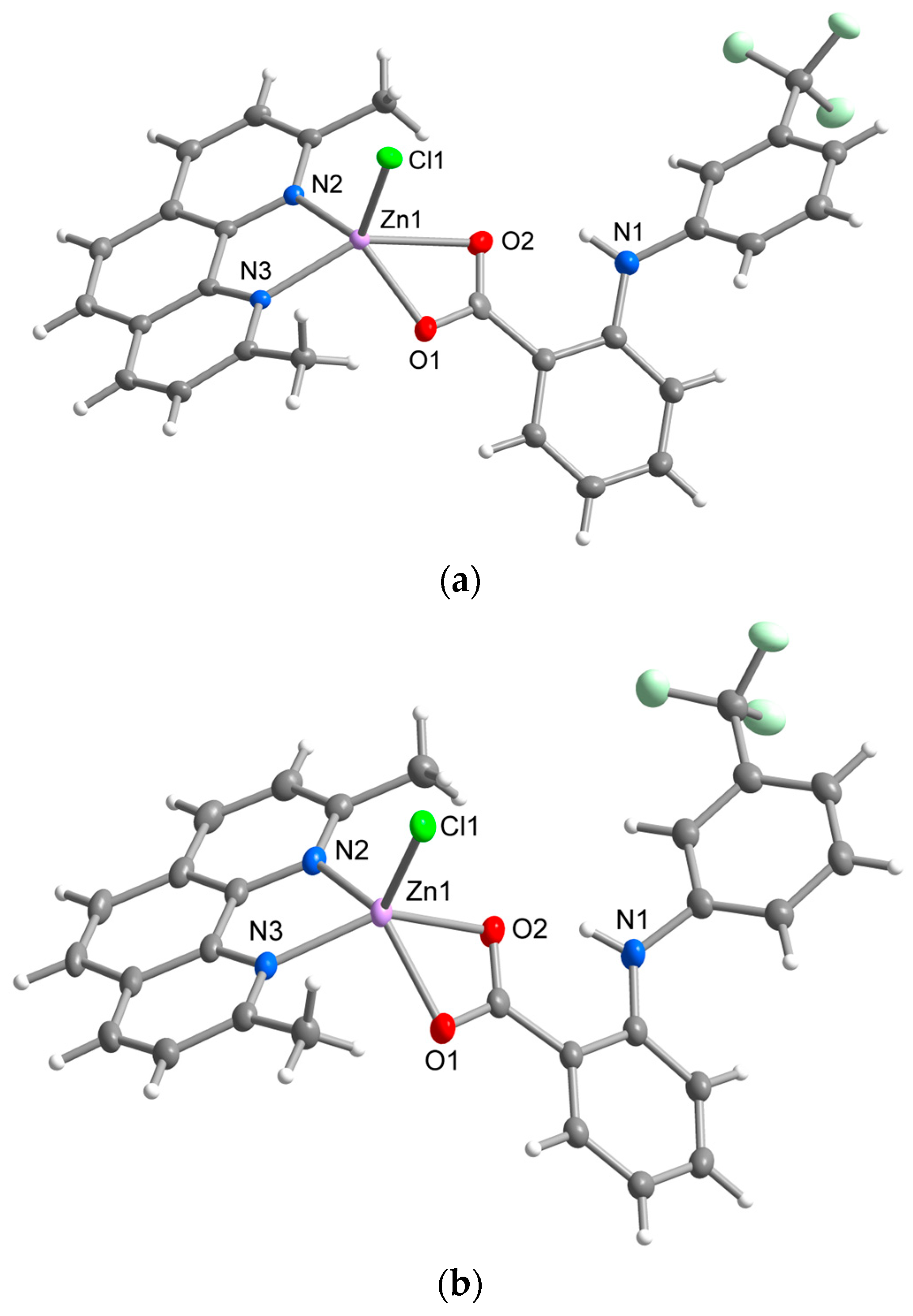
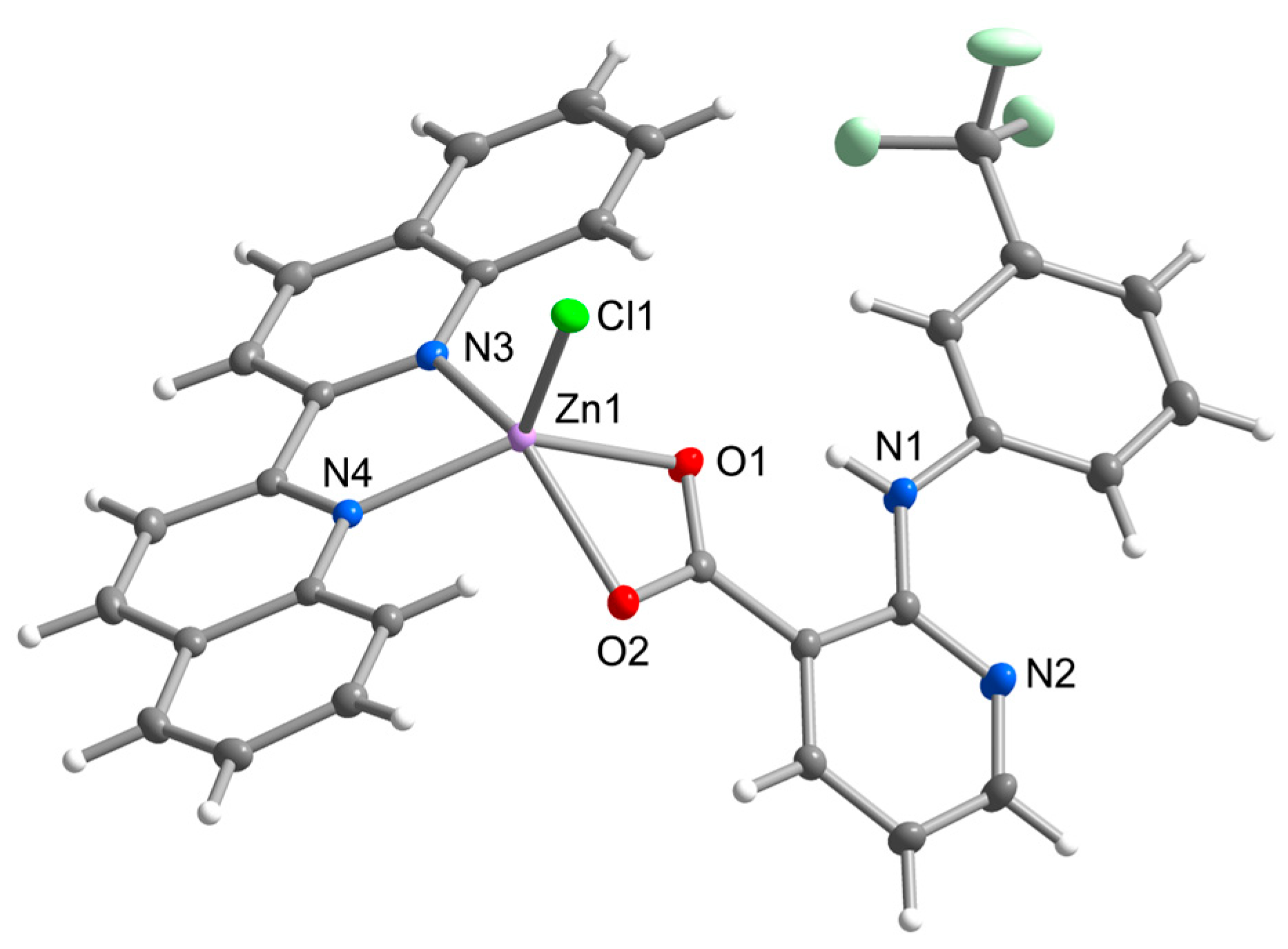

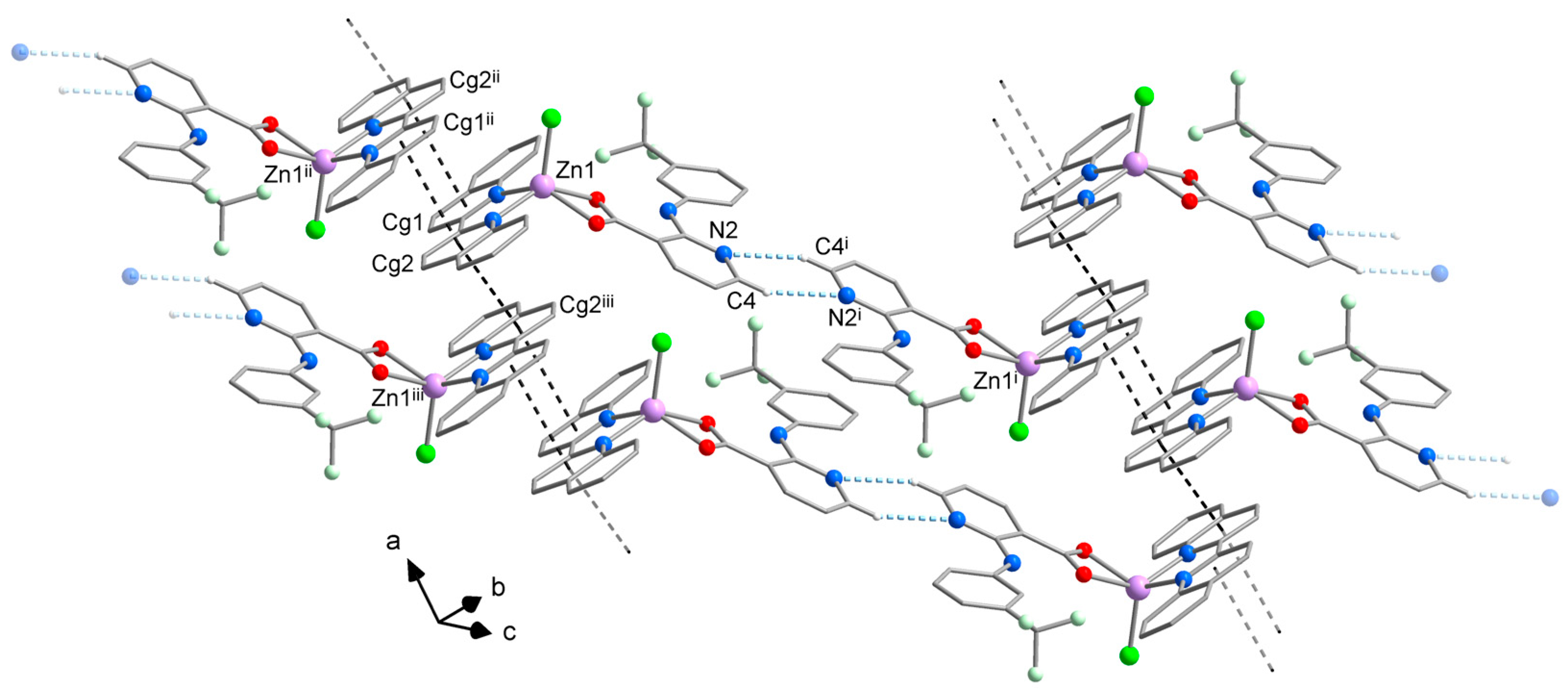
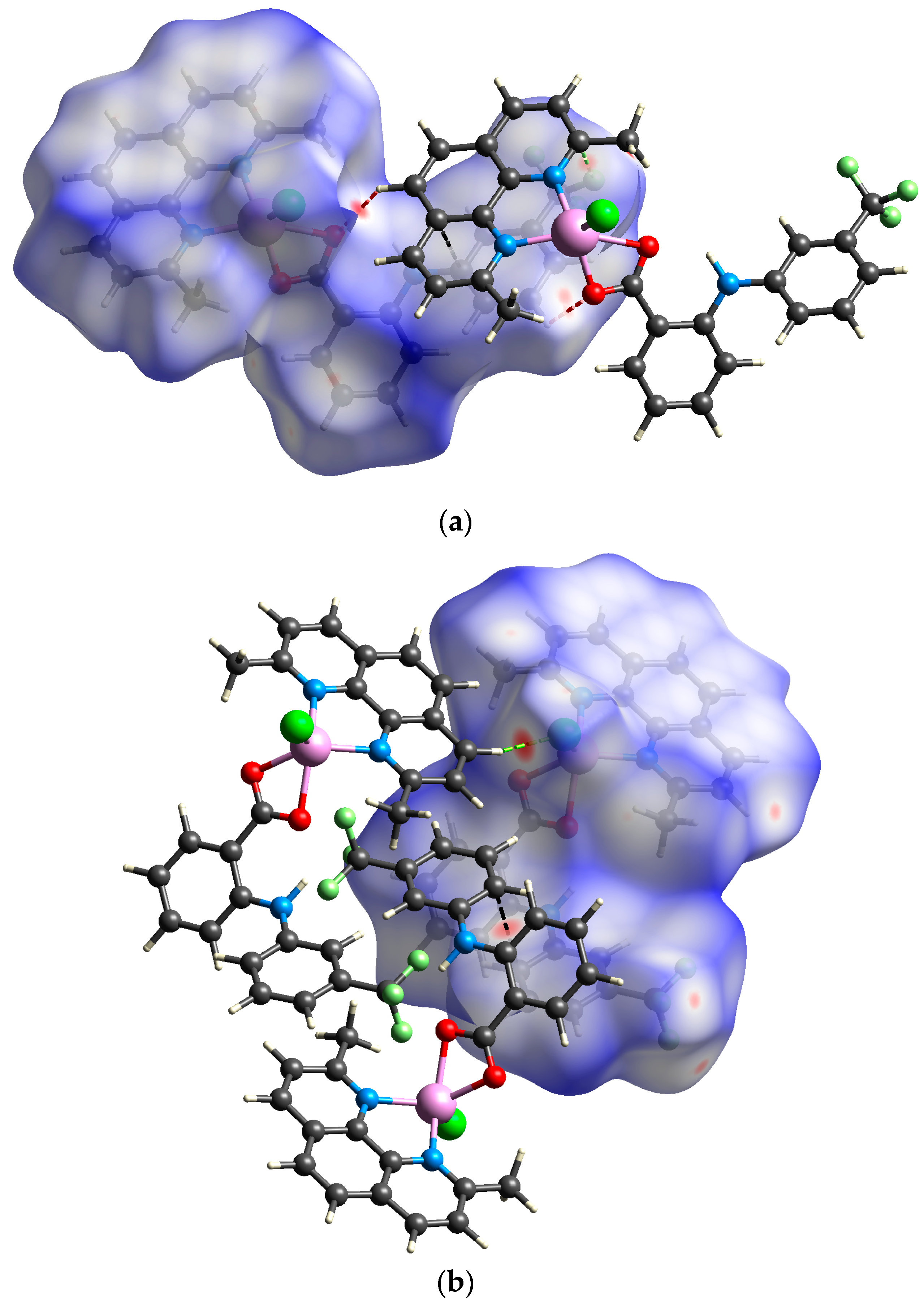
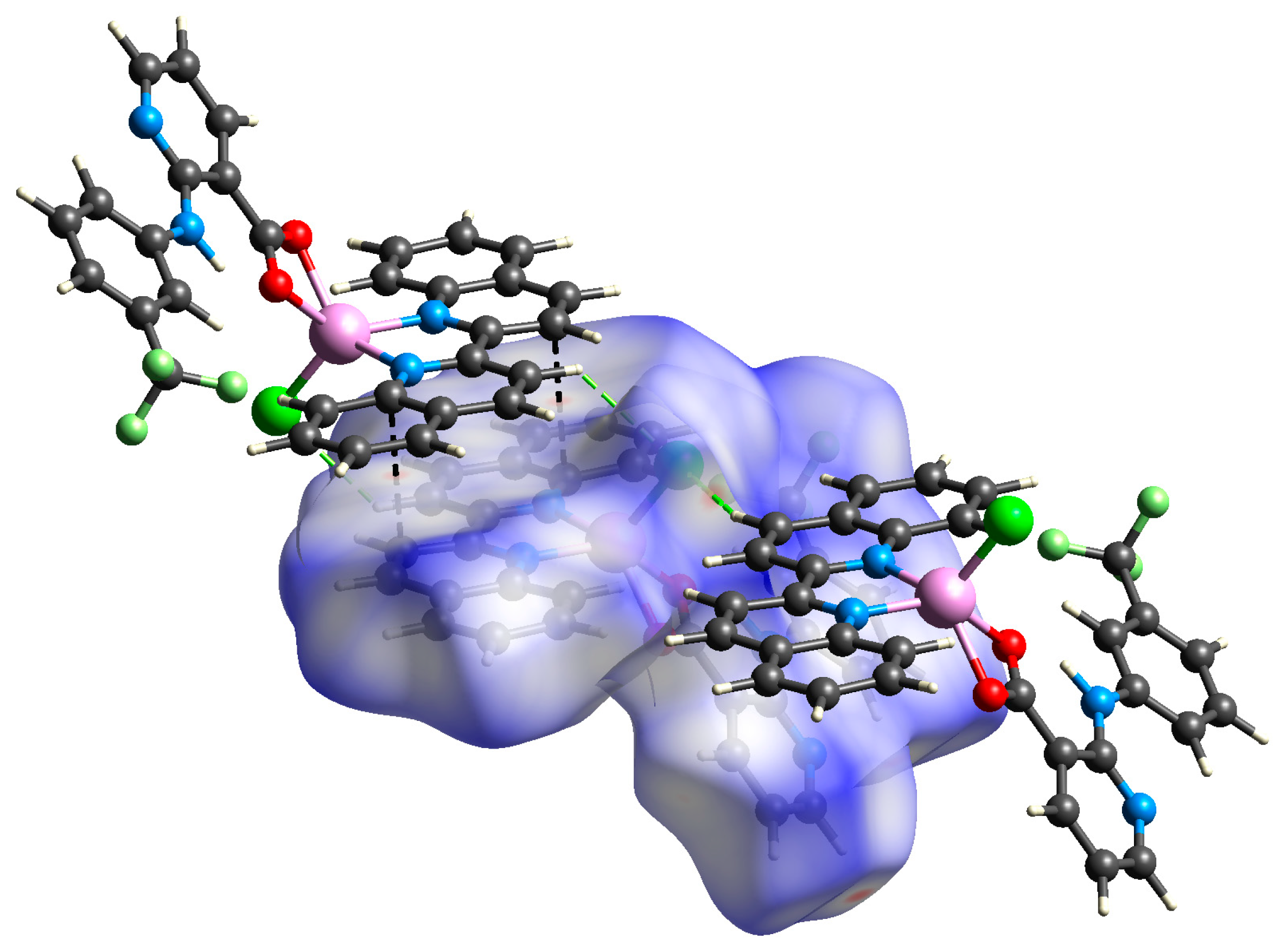

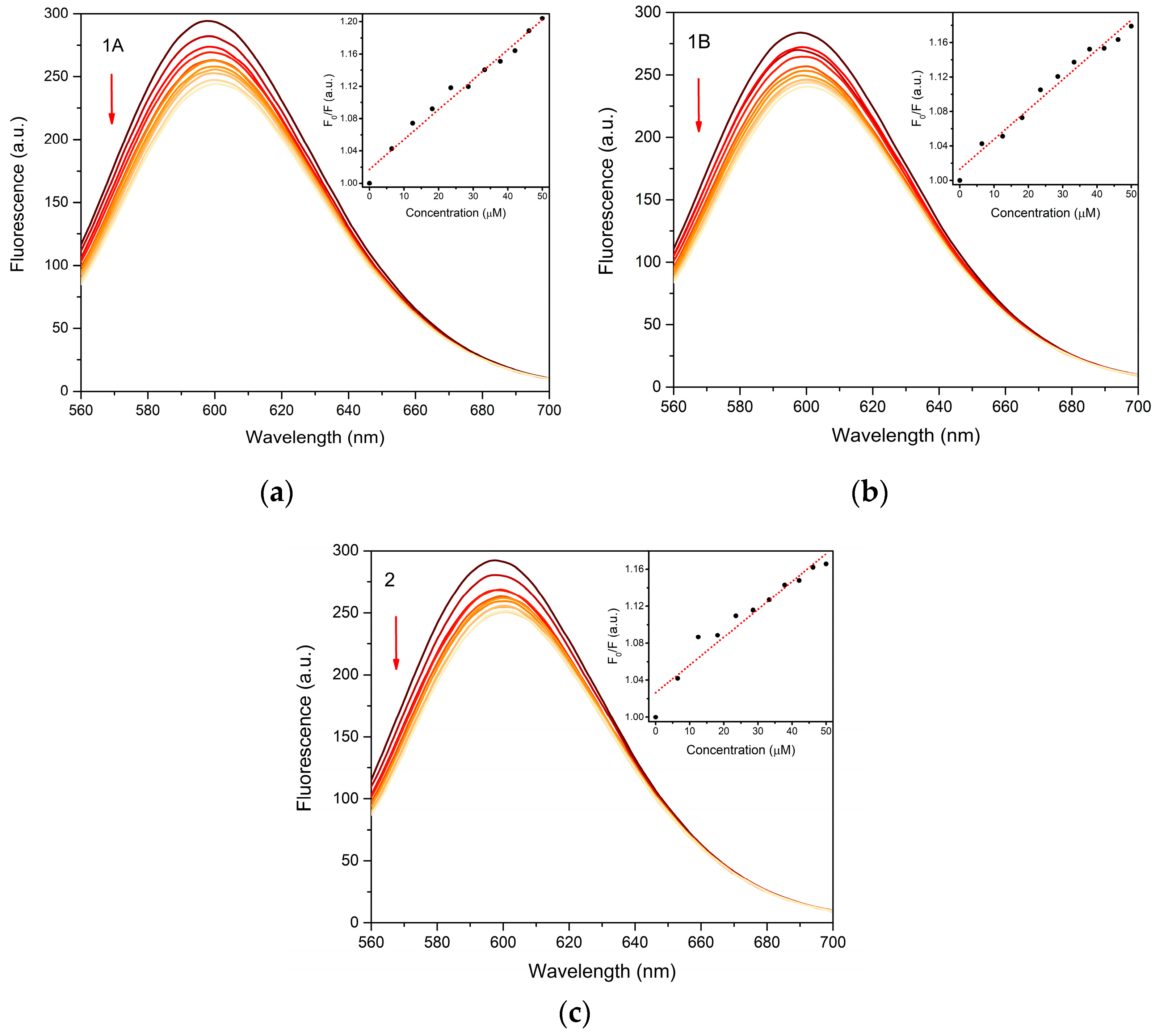
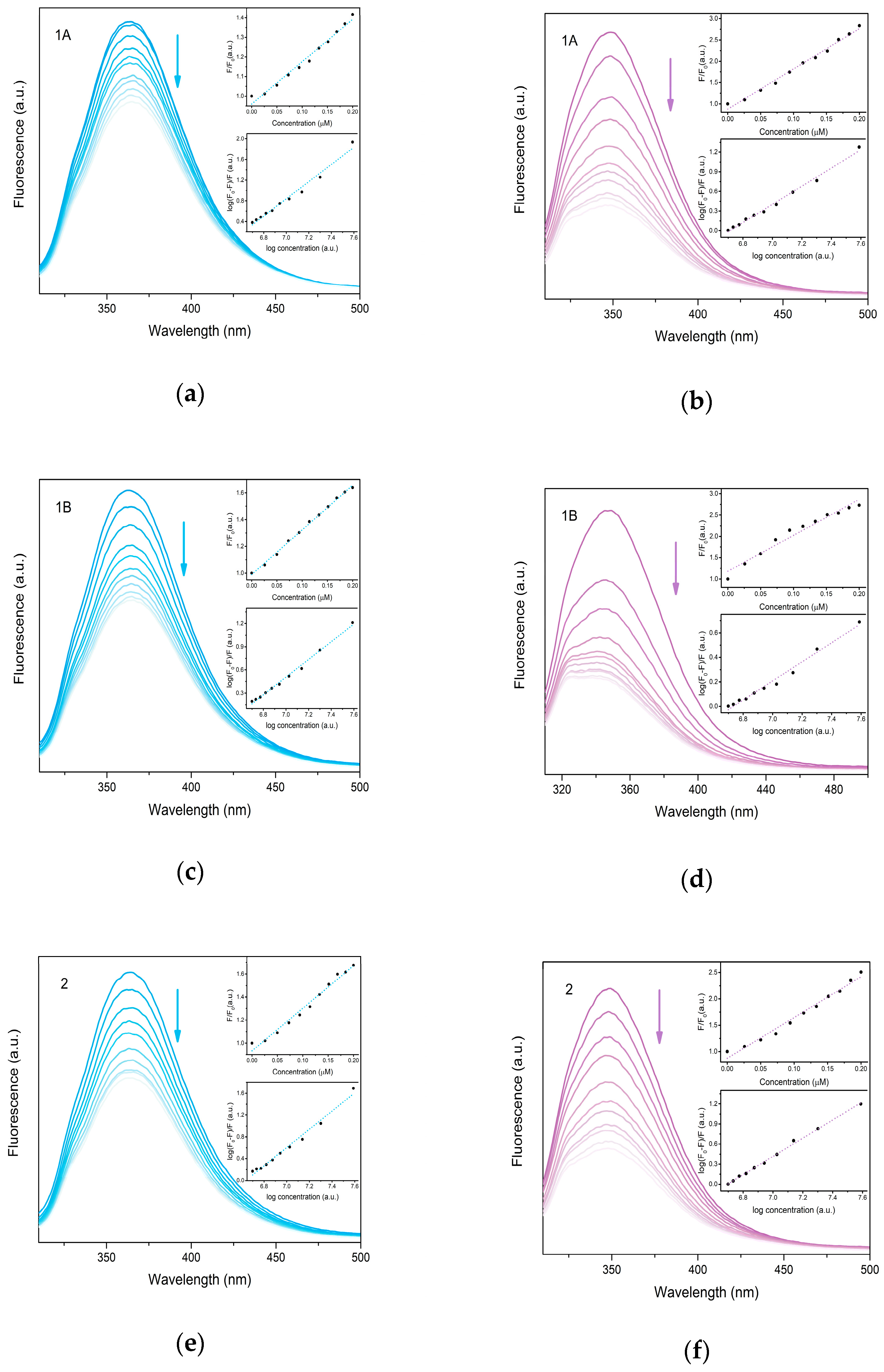
| Complex | 1A | 1B | 2 |
|---|---|---|---|
| CCDC reference | 2290944 | 2290945 | 2290946 |
| Empirical formula | C28H21ClF3N3O2Zn | C28H21ClF3N3O2Zn | C31H20ClF3N4O2Zn |
| Formula weight | 589.3 | 589.3 | 638.4 |
| Temperature (K) | 95 | 95 | 95 |
| Wavelength (Å) | 1.54184 | 1.54184 | 1.54184 |
| Crystal System | Triclinic | Triclinic | Triclinic |
| Space Group | P-1 | P-1 | P-1 |
| a (Å) | 9.5840(2) | 8.2719(2) | 8.0257(2) |
| b (Å) | 9.6712(2) | 9.8259(2) | 9.8491(2) |
| c (Å) | 14.6728(2) | 15.8496(3) | 17.6069(3) |
| α (°) | 89.112(2) | 82.724(1) | 98.728(1) |
| β (°) | 88.112(2) | 78.425(2) | 102.955(2) |
| γ (°) | 62.964(2) | 84.232(1) | 100.143(2) |
| Cell volume (Å3) | 1210.73(4) | 1248.13(5) | 1308.34(5) |
| Z | 2 | 2 | 2 |
| ρcalculated (g.cm−3) | 1.6165 | 1.568 | 1.620 |
| μ (mm−1) | 2.921 | 2.833 | 2.771 |
| Crystal color and shape | yellow plate | colorless prism | yellow needle |
| Crystal dimensions (mm) | 0.41 × 0.12 × 0.03 | 0.25 × 0.20 × 0.15 | 0.22 × 0.10 × 0.04 |
| θ range data collection (°) | 3.01–71.48 | 2.86–74.75 | 2.63–74.81 |
| Reflections collected | 15,759 | 21,301 | 22,309 |
| Independent reflections | 4661 | 5020 | 5278 |
| Rint | 0.0382 | 0.0295 | 0.0212 |
| Data/restraints/parameters | 4661/0/347 | 5020/0/346 | 5278/0/383 |
| Goodness-of-fit 1 | 2.511 | 1.955 | 2.264 |
| Final R indices (I > 3σ/I) | R1 = 0.0379 wR2 = 0.0938 | R1 = 0.0293 wR2 = 0.0754 | R1 = 0.0226 wR2 = 0.0671 |
| R indices (all data) | R1 = 0.0402 wR2 = 0.0947 | R1 = 0.0329 wR2 = 0.0770 | R1 = 0.0241 wR2 = 0.0679 |
| Residual electron density [e. Å−3] | −0.59; 0.42 | −0.32; 0.20 | −0.26; 0.23 |
| Parameter | 1A | 1B | Parameter | 2 |
|---|---|---|---|---|
| Zn1-O1 | 1.9866(15) | 2.1330(14) | Zn1-O1 | 2.1577(9) |
| Zn1-O2 | 2.5101(19) | 2.1788(13) | Zn1-O2 | 2.1556(10) |
| Zn1-N2 | 2.0814(18) | 2.0918(14) | Zn1-N3 | 2.1023(10) |
| Zn1-N3 | 2.0950(20) | 2.0983(15) | Zn1-N4 | 2.0979(10) |
| Zn1-Cl1 | 2.2290(6) | 2.2210(5) | Zn1-Cl1 | 2.2187(4) |
| O1-Zn1-O2 | 56.95(7) | 60.81(5) | O1-Zn1-O2 | 61.02(4) |
| N2-Zn1-N3 | 80.18(7) | 80.53(6) | N2-Zn1-N3 | 79.02(4) |
| FS DNA | ΔF (%) | KSV (M−1) |
|---|---|---|
| 1A | 16.96 | 3.71 × 103 |
| 1B | 15.19 | 3.46 × 103 |
| 2 | 14.21 | 3.01 × 103 |
| HSA | ΔF (%) | KSV (M−1) | Kb (M−1) | n |
| 1A | 29.41 | 2.16 × 106 | 2.10 × 109 | 1.39 |
| 1B | 38.98 | 3.33 × 106 | 1.29 × 109 | 1.36 |
| 2 | 40.33 | 3.69 × 106 | 2.99 × 105 | 0.78 |
| BSA | ΔF (%) | KSV (M−1) | Kb (M−1) | n |
| 1A | 64.75 | 9.44 × 106 | 6.37 × 1010 | 1.66 |
| 1B | 63.37 | 8.43 × 106 | 1.29 × 1011 | 1.67 |
| 2 | 60.13 | 7.73 × 106 | 3.19 × 107 | 1.14 |
Disclaimer/Publisher’s Note: The statements, opinions and data contained in all publications are solely those of the individual author(s) and contributor(s) and not of MDPI and/or the editor(s). MDPI and/or the editor(s) disclaim responsibility for any injury to people or property resulting from any ideas, methods, instructions or products referred to in the content. |
© 2023 by the authors. Licensee MDPI, Basel, Switzerland. This article is an open access article distributed under the terms and conditions of the Creative Commons Attribution (CC BY) license (https://creativecommons.org/licenses/by/4.0/).
Share and Cite
Smolková, R.; Smolko, L.; Poupon, M.; Samoľová, E. Pentacoordinate Mixed-Ligand Zn(II) Complexes with Flufenamato and Niflumato Ligands: Crystal Structure, Spectral Characterization and Biological Properties. Crystals 2023, 13, 1460. https://doi.org/10.3390/cryst13101460
Smolková R, Smolko L, Poupon M, Samoľová E. Pentacoordinate Mixed-Ligand Zn(II) Complexes with Flufenamato and Niflumato Ligands: Crystal Structure, Spectral Characterization and Biological Properties. Crystals. 2023; 13(10):1460. https://doi.org/10.3390/cryst13101460
Chicago/Turabian StyleSmolková, Romana, Lukáš Smolko, Morgane Poupon, and Erika Samoľová. 2023. "Pentacoordinate Mixed-Ligand Zn(II) Complexes with Flufenamato and Niflumato Ligands: Crystal Structure, Spectral Characterization and Biological Properties" Crystals 13, no. 10: 1460. https://doi.org/10.3390/cryst13101460
APA StyleSmolková, R., Smolko, L., Poupon, M., & Samoľová, E. (2023). Pentacoordinate Mixed-Ligand Zn(II) Complexes with Flufenamato and Niflumato Ligands: Crystal Structure, Spectral Characterization and Biological Properties. Crystals, 13(10), 1460. https://doi.org/10.3390/cryst13101460






